Control, Computing and Data
Electron Beam Diagnostics:
1) Multi-Parameters Bunch-by-Bunch Diagnosis in Electron Storage Rings
Research focuses on novel modulation, detection, and analysis methods for beam signals, along with new sampling, conditioning, and processing techniques to extract multidimensional per-bunch information from a single broadband beam probe signal. For the first time globally, synchronous precise measurements of three-dimensional position, bunch length, and charge quantity were achieved for individual bunches in an electron storage ring, including the separation of three-dimensional position information for injected bunches. Using button electrodes coupled to image currents and visible synchrotron radiation as signal sources, high-speed digital oscilloscopes served as data acquisition devices. Offline software packages analyzed the massive datasets collected by the oscilloscopes, enabling accurate measurements of multiple parameters such as charge quantity and lifetime [1-2], transverse position [3-4], longitudinal position [5-7], transverse cross-section size [8-9], and longitudinal length [10-11]. Based on this foundation, an open-source software package named HOTCAP [14-15] was developed, capable of simultaneously measuring multiple parameters [12-13] and applicable to any high-energy electron storage ring. The transverse position resolution exceeds 5 μm, longitudinal phase resolution is better than 0.2 ps, and bunch length resolution surpasses 1 ps. Several application studies were conducted, including injection transient process performance evaluation [16-17], observation of damping oscillations in replenishment bunches [18], extraction of initial parameters for the longitudinal phase space of freshly injected bunches [19], analysis of beam transverse wakefields [20], assessment of beam loading effects [21], and in-situ diagnosis of optical parameters [22].
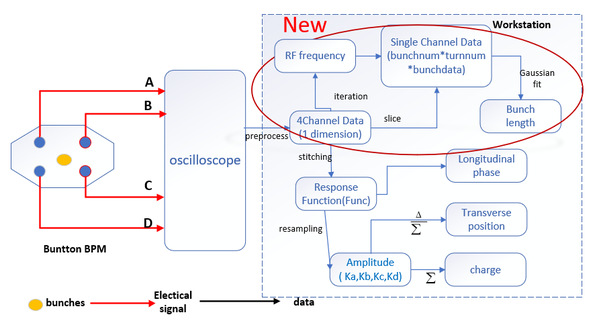
System diagram of 5D bunch-by-bunch (BYB) Monitor
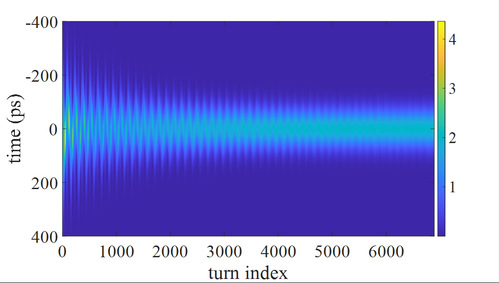
Reconstruction result of aninjected bunch’s longitudinal distribution using 5D BYB monitor
Reference
[1] Bo Gao, Fangzhou Chen, Yimei Zhou, Yongbin Leng*, Bunch-by-bunch beam lifetime measurement at SSRF, Nuclear Instruments and Methods in Physics Research Section A: Accelerators, Spectrometers, Detectors and Associated Equipment, Volume 1015, 1 November 2021, 165758, https://doi.org/10.1016/j.nima.2021.165758
[2] Chen, F., Chen, Z., Zhou, Y. Leng Y. (*) et al. Touschek lifetime study based on the precise bunch-by-bunch BCM system at SSRF. NUCL SCI TECH 30, 144 (2019)
[3] Zhang Ning, Leng Yongbin*, Chen Zhichu, et al. Development of a Bunch-by-Bunch Position Monitoring System Based on Oscilloscope-Embedded IOC Technology [J]. Nuclear Techniques, 2012. (in Chinese)
[4] Xing Yang, Hong Shuang Wang, Yi Mei Zhou, Yong Bin Leng*, Determining beam transverse absolute position by triangulation of multi‑electrode signal phase differences, Nuclear Science and Techniques, 23 July 2024, Volume 35, article number 89, (2024), https:// doi.org/10.1007/s41365-024-01498-y
[5] Zhou Y M, Chen H J, Cao S S, et al. Bunch-by-bunch longitudinal phase monitor at SSRF[J]. Nuclear Science and Techniques, 2018, 29(8): 113.
[6] Zhou Yimei, Leng Yongbin*, Xu Xinyi, Gao Bo, Cao Shanshan. Optimization of Signal Processing Algorithms for Storage Ring Bunch-by-Bunch Phase Measurement System [J]. High Power Laser and Particle Beams, 2020, 32: 000000. DOI: 10.11884/HPLPB202032.190033 (in Chinese)
[7] You‑Ming Deng, Yong‑Bin Leng*, Xing‑Yi Xu, Jian Chen, Yi‑Mei Zhou, Ultrahigh spatiotemporal resolution beam signal reconstruction with bunch phase compensation, Nuclear Science and Techniques, 3 June 2024, Volume 35, article number 133, (2024), https://doi.org/10.1007/s41365-024-01444-y
[8] Chen H J, Chen J, Gao B, Leng Y. (*) et al. Bunch-by-bunch beam size measurement during injection at Shanghai Synchrotron Radiation Facility[J]. Nuclear Science and Techniques, 2018, 29(6): 79.
[9] Yimei Zhou, Yongbin Leng*, Sang Wu, Huizhong Bai, Longwei Lai, Fangzhou Chen and Ning Zhang, A novel approach to beam size measurement at SSRF, Journal of Physics: Conference Series 3010 (2025) 012093
[10] Duan L W, Leng Y B*, Yuan R X, et al. Injection transient study using a two-frequency bunch length measurement system at the SSRF[J]. Nuclear Science and Techniques, 2017, 28(7): 93.
[11] Hong‑Shuang Wang, Xing Yang, Yong‑Bin Leng*, Yi‑Mei Zhou, Ji‑Gang Wang, Bunch‑length measurement at a bunch‑by‑bunch rate based on time–frequency‑domain joint analysis techniques and its application, Nuclear Science and Techniques, 24 May 2024, Volume 35, article number 80, (2024), https://doi.org/10.1007/s41365-024-01443-z
[12] Xingyi Xu,Yongbin Leng*, Yimei Zhou, Bo Gao, Jian Chen, and Shanshan Cao,Bunch-by-bunch three-dimensional position and charge measurement in a storage ring,PHYSICAL REVIEW ACCELERATORS AND BEAMS 24, 032802 (2021)
[13] Youming Deng, Yongbin Leng*, Yimei Zhou et al., Research Progress on Bunch-by-Bunch Diagnosis Technology in Electron Storage Rings, Nuclear Techniques, October 2024, Vol. 47, No. 10. (in Chinese)
[14] Xing-Yi Xu,Yong-Bin Leng*,Bo Gao,etc.,HOTCAP: a new software package for high-speed oscilloscope based three-dimensional bunch charge and position measurement,NUCL SCI TECH (2021) 32:131
[15] Xing Yang, Yongbin Leng*, Yimei Zhou, Real-Time Performance Optimization of the HOTCAP Software for Three-Dimensional Bunch Information Extraction, Nuclear Techniques, February 2024, Vol. 47, No. 2, pp. 020102-1-8. (in Chinese)
[16] Yong Y, Yong-Bin L*, Ying-Bing Y, et al. Injection performance evaluation for SSRF storage ring[J]. Chinese physics C, 2015, 39(9): 097003.
[17] Yimei Zhou, Yongbin Leng* et al., Extraction of Three-Dimensional Position Information of Replenishment Charge During Injection in Electron Storage Rings, Atomic Energy Science and Technology, Vol. 54, No. 11, 2020. (in Chinese)
[18] Yimei Zhou(†); Zhichu Chen; Bo Gao; Ning Zhang; Yongbin Leng(*), Bunch-by-bunch phase study of the transient state during injection, NIMA,955(2020) 163273, https://doi.org/10.1016/j.nima.2019.163273
[19] Hongshuang Wang, Yongbin Leng*, andYimei Zhou, Technique for Extracting Initial Parameters of Longitudinal Phase Space of Freshly Injected Bunches in Storage Rings, and Its Applications, Instruments 2025, 9, 17, https://www.mdpi.com/2410-390X/9/3/17
[20] Chen Z, Yang Y, Leng Y*, et al. Wakefield measurement using principal component analysis on bunch-by-bunch information during transient state of injection in a storage ring[J]. PRAB, 2014, 17(11): 112803.
[21] Yimei Zhou, Yongbin Leng*, Longwei Lai, Xingyi Xu, Tianlong He, Experimental verification and analysis of the beam loading effect based on precise bunch-by-bunch 3D position measurement, Nuclear Inst. and Methods in Physics Research, A, 1051 (2023) 168201
[22] Xingyi Xu,Yongbin Leng*, New noninvasive measurement method of optics parameters in a storage ring using bunch-by-bunch 3D beam position measurement data,PHYSICAL REVIEW ACCELERATORS AND BEAMS 24, 062802 (2021)
2) Application of Machine Learning Technology in Beam Diagnostics
Exploration of machine learning applications in particle accelerator beam measurement and feedback control. Key recent research includes: creating accelerator operating state spaces based on multidimensional beam parameter measurements, applying clustering algorithms to analyze these states for operational status evaluation and prediction [1-2]; using raw multi-bunch, multi-turn voltage waveform data sampled by broadband probes as input to a hybrid neural network architecture incorporating spatiotemporal features, achieving end-to-end joint prediction of bunch length, phase, and transverse position through collaborative design of shared feature extraction layers and dedicated prediction branches; addressing potential signal reflection and crosstalk issues during beam signal transmission by employing convolutional neural networks (CNNs) with multi-channel beam sampling signals exhibiting similar characteristics to solve for reflection and crosstalk coefficients, thereby separating source signals from interference [3]; utilizing CNNs to analyze monitoring data of beam transverse or longitudinal oscillations for rapid and precise fitting of multiple accelerator and beam parameters [4]; attempting to train an intelligent agent on the Hefei Infrared FEL facility using Deep Deterministic Policy Gradient (DDPG) and Soft Actor-Critic (SAC) algorithms from reinforcement learning for automatic parameter optimization during operation; solving the problem of fast analysis of measured longitudinal distribution data for injected bunches by extracting feature vectors from MobileNetV2 network-processed data images and matching them against simulated standard databases, enabling reverse extraction of initial beam parameters during electron storage ring injection [5]. A deep fully connected neural network approach (FEL Power Predictor) was implemented to analyze multi-bunch transverse position, charge, and longitudinal phase data obtained from BPMs upstream and downstream of the undulator, constructing a high-precision laser power prediction model. This addresses the challenge of real-time, non-destructive monitoring of infrared free-electron laser (FEL) output power, providing data-driven guidance for device parameter optimization [6].
Reference
[1] Zikun Fang, Tianyu Jiang, Yimei Zhou, Yongbin Leng (*), Machine Learning Based Injection Quality Assessment and Anomaly Detection in Electron Storage Rings, Nuclear Techniques (Under Review, in Chinese).
[2] JIANG Ruitao, YANG Xing, DENG Youming, LENG Yongbin∗, Diagnostic Method for Beam Position Monitor Based on Clustering by Fast Search and Find of Density Peaks, J. Shanghai Jiao Tong Univ. (Sci.), 2022, https://doi.org/10.1007/s12204-022-2546-y
[3] Chen J, Leng Y B *, Yu L Y, et al. Study of the crosstalk evaluation for cavity BPM[J]. Nuclear Science and Techniques, 2018, 29(6): 83.
[4] Xinyi Xu(†); Yimei Zhou; Yongbin Leng(*), Machine learning based image processing technology application in bunch longitudinal phase information extraction, PRAB 23, 032805 (2020)
[5] Tianyu Jiang, Jerry Jin, Yimei Zhou, Hongshuang Wang, Xing Yang and Yongbin Leng, Analysis of Longitudinal Phase Space Evolution of Fresh Injected Beam in Electron Storage Ring Based on Image Matching, JINST(under review)
[6] C. Liu, X. Yang, Y. M. Deng, Y. B. Leng†, PREDICTION OF FEL PERFORMANCE USING BPM MEASUREMENTS AND MACHINE LEARNING, IBIC2025
3) Cavity based Multi-Parameter Diagnostic Technology
Optimization design methods for resonant cavity probes, improved algorithms for multi-parameter information extraction from cavity probes, and integration/optimization techniques for beam measurement systems based on cavity probes. To meet the precise bunch position measurement requirements of FEL facilities, a C-band cavity probe radio frequency (RF) signal conditioning front-end was developed [1]. Theoretical analysis and experimental validation were performed on the optimized amplitude extraction algorithm for cavity probe signals [2]. Building upon this, studies discussed optimization design methods for parameter matching between different modules within such integrated systems [3], completed system integration [4], and conducted application research on precise charge measurement [5-6], arrival time measurement [7-10], and bunch trajectory deflection angle measurement [11].
Reference
[1] Jian Chen, Fangzhou Chen, Yongbin Leng*, Development of a Radio Frequency Signal Conditioning Front-End for the Cavity-Based CBPM System, Atomic Energy Science and Technology, October 2022, Vol. 56, No. 10. (in Chinese)
[2] Jian Chen, Shanshan Cao, Yongbin Leng*,Study of the optimal amplitude extraction algorithm for cavity BPM,Nuclear Instruments and Methods in Physics Research Section A: Accelerators, Spectrometers, Detectors and Associated Equipment Volume 1012, 1 October 2021, 165627, https://doi.org/10.1016/j.nima.2021.165627
[3] Jian Chen, Yongbin Leng*, Shanshan Cao, Longwei Lai, Renxian Yuan, Ruitao Jiang, Xing Yang, Optimized design method study for cavity BPM system, Nuclear Instruments and Methods in Physics Research Section A: Accelerators, Spectrometers, Detectors and Associated Equipment, Volume 1044, 1 December 2022, 167509, https://doi.org/10.1016/j.nima.2022.167509
[4] Jian Chen, Yongbin Leng* et al., Shanghai Soft X-ray Free-Electron Laser Cavity-Based Beam Position Monitoring System, Atomic Energy Science and Technology, Vol. 54, No. 10, 2020. (in Chinese)
[5] Shanshan Cao, Yongbin Leng*, Renxian Yuan, Longwei Lai, Jian Chen. Study on High-Resolution Bunch Charge Measurement Method Based on Cavity Probes [J]. Nuclear Techniques, 2021, Vol. 44, No. 4. DOI: 10.11889/j.0253-3219.2021.hjs.44.040101. (in Chinese)
[6] Shanshan Cao, Yongbin Leng*, Renxian Yuan, et al.. Accurate Beam Current Measurement Based on Dual-Cavity Probes [J]. Nuclear Techniques, 2019, 42(4): 40101-040101. (in Chinese)
[7] Shanshan Cao, Yongbin Leng*, Renxian Yuan, and Jian Chen, Optimization of beam arrival and flight time measurement system based on cavity monitors at the SXFEL, IEEE TRANSACTIONS ON NUCLEAR SCIENCE, VOL. 68, NO. 1, JANUARY 2021
[8] Shanshan Cao, Yongbin Leng∗, Renxian Yuan, Jian Chen, An application of a cavity-based beam arrival time measurement system: Beam energy measurement, Nuclear Inst. And Methods in Physics Research, A, Volume 1045, 1 January 2023, 167456, https://doi.org/10.1016/j.nima.2022.167456
[9] Cao, S., Yuan, R., Chen, J., Leng Y. (*) et al. Dual-cavity beam arrival time monitor design for the Shanghai soft X-ray FEL facility. NUCL SCI TECH 30, 72 (2019)
[10] Yimei Zhou, Yongbin Leng*, Jian Chen, Shanshan Cao, Xingyi Xu, Longwei Lai, Algorithm Optimization for Bunch Arrival Time Measurement Based on Cavity Probes, Atomic Energy Science and Technology, October 2022, Vol. 56, No. 10, pp. 2104-2112. (in Chinese)
[11] Jian Chen, Shanshan Cao, Luyang Yu, Longwei Lai, Renxian Yuan, Fangzhou Chen, and Yongbin Leng*, In situ beam trajectory tilt measurement based on single cavity beam position monitor, Phys. Rev. Accel. Beams 26, 102802
4) Beam Diagnostic Based on Optical Technology
This research focuses on developing novel synchrotron light modulation approaches integrated with computational imaging technologies to explore high-precision, high-speed diagnostic methodologies for beam cross-section profiling and longitudinal bunch distribution characterization. It aims to address the challenges of low synchrotron light utilization efficiency and the inherent trade-off between measurement accuracy and speed. Through complex mask encoding techniques, direct manipulation of broadband, multi-spatial-frequency synchrotron radiation will be achieved. Color cameras or single-pixel imaging systems will enable one-shot capture of multi-wavelength interference patterns or highly sensitive intensity distributions, followed by efficient parameter extraction via computational inversion algorithms. Currently, a dedicated wave-optical numerical simulation tool has been developed, validated through proof-of-concept experiments using a polychromatic spatial interferometer, and completed theoretical modeling and optimization for both color camera and single-pixel detector configurations.
Reference
[1] Gao B, Leng Y B*, Chen H J, et al. Upgrade of the X-ray pinhole camera system at SSRF[J]. Nuclear Science and Techniques, 2018, 29(8): 115.
[2] Gao Bo, Leng Yongbin*, Chen Hanjiao, Chen Jie. Rapid Grating Pitch Scanning System for Synchrotron Light Spatial Interferometer [J]. Nuclear Techniques, 2018, 41(8): 080101. DOI: 10.11889/j.0253-3219.2018.hjs.41.080101. (in Chinese)
[3] Yong-Bin L*, Guo-Qing H, Man-Zhou Z, et al. The beam-based calibration of an X-ray pinhole camera at SSRF[J]. Chinese physics C, 2012, 36(1): 80.
[4] Chen Jie, Ye Kairong, Leng Yongbin*. Development of Spatial Interferometer for Shanghai Synchrotron Radiation Facility [J]. Nuclear Techniques, January 2011, Vol. 23, No. 1. (in Chinese)
5) Development and Application of Beam Signal Processors
This involves the development and application of dedicated signal processors based on FPGA and high-speed ADC/DAC (with sampling rates ranging from hundreds of MHz to GHz). Key aspects include hardware/software architecture design, implementation, and optimization of novel signal processing algorithms within FPGAs. A ultra-low-latency specialized beam signal processor meeting the orbit measurement requirements of Hefei Advanced Light Source storage ring has been successfully developed. Employing dual pilot tone technology for channel consistency compensation, it achieves position measurement resolution better than 20 nm at 2 Hz bandwidth, better than 200 nm at 10 kHz bandwidth (FA mode), and turn-by-turn position resolution below 500 nm, with FA data processing latency under 90 μs—reaching international advanced levels. Another bunch-by-bunch beam signal processor tailored for Hefei IRFEL facility has been completed, featuring transverse position resolution finer than 20 μm and longitudinal phase resolution better than 1 ps, attaining world-leading performance. Supported by the Major Facilities Maintenance & Renovation Project of Chinese Academy of Sciences, we have initiated the development of a universal signal processing platform for beam control. The proposed solution utilizes a digital signal processing motherboard integrated with two FMC signal I/O daughterboards to accommodate most control and measurement applications.

Photo of the low-latency DBPM processor prototype
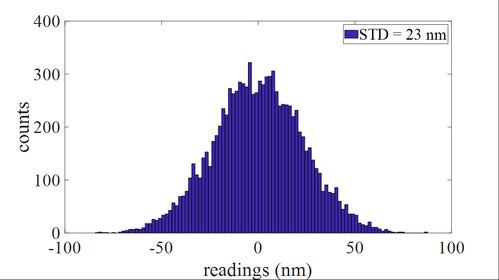
Position resolution of the DBPM processor prototype
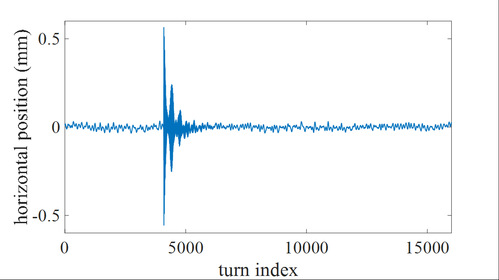
Captured horizontal position waveform with the DBPM prototype during injection
Reference
[1] Lai Longwei, Leng Yongbin*, Yan Yingbing. Development and Application of Digital Beam Position Signal Processor for Free-Electron Laser Facility [J]. Nuclear Techniques, July 2018, 41(7): 070402. (in Chinese)
[2] Chen Fangzhou, Lai Longwei, Yan Yingbing, Leng Yongbin*. Development of Test Platform for Digital Beam Position Signal Processor at Shanghai Synchrotron Radiation Facility [J]. Nuclear Techniques, November 2017, Vol. 40, Issue 11. (in Chinese)
[3] Lai Longwei, Leng Yongbin*, Yan Yingbing. Progress in Development of Digital BPM Signal Processor [J]. Atomic Energy Science and Technology, October 2015, Supplement to Vol. 49: 607–610. (in Chinese)
[4] Sun Xudong, Leng Yongbin*. Implementation and Integration of a Systematic DBPM Calibration with PLL Frequency Synthesis and FPGA [J]. NST, 2014, 25(2): 20401-020401.
[5] Lai Longwei, Leng Yongbin*, Yi Xing. Optimization of Digital Beam Position Signal Processing Algorithms [J]. High Power Laser and Particle Beams, January 2013, 25(1): 109–113. (in Chinese)
[6] Yi Xing, Leng Yongbin*, Lai Longwei. Novel Digital Beam Position Processor Based on Software Radio [J]. Nuclear Techniques, May 2012, 35(5): 346–351. (in Chinese)
[7] Longwei L, Yongbin L*, Xing Y, et al. DBPM Signal Processing with Field Programmable Gate Arrays [J]. NST, 2013, 22(3): 129–133.
[8] Leng Yongbin*, Yi Xing, Lai Longwei. Progress in Development of Novel Digital BPM Signal Processor [J]. Nuclear Techniques, May 2011, 34(5): 326–330. (in Chinese)
[9] Xing Y, Yongbin L*, Longwei L, et al. RF Front-End for Digital Beam Position Monitor Signal Processor [J]. NST, 2011, 22(2011): 65–69.
[10] Lai Longwei, Leng Yongbin*, Yan Yingbing. Research on Digital BPM Signal Processing Algorithms [J]. Nuclear Techniques, October 2010, Vol. 33, Issue 10. (in Chinese)
Control Technology
1) Technologies for improving availability
Availability is a metric that combines reliability and maintainability. Higher reliability and better maintainability result in greater availability. For accelerator control systems, common methods to improve availability include redundancy technology, fault analysis and localization technology, alarm technology, and process automation technology. Redundancy technology is used to enhance system reliability and can be applied at different levels of an accelerator control system such as server systems, network systems, front-end controllers, and I/O devices. A fully redundant EPICS control system architecture based on PROFINET was designed [1] and applied to the HLS-II Personnel Safety System [2]. Fault analysis and localization technology relies on the support of a data archiving system. Regarding the archiving system, research has been carried out on technologies such as configuration automation, web-based visualization, and archiving database performance [3-6]. The alarm system is used to monitor the operational status of the accelerator in real-time and deliver the most critical information to relevant personnel within a reasonable time frame, playing a vital role in ensuring the stable operation of the facility. In terms of alarm technology, multiple information distribution methods, including SMS, WeChat, and web, have been developed, and various methods to suppress nuisance alarms have been studied [7-8].
Reference
[1] Huang Z, Song Y, Wan K, et al. A REDUNDANT EPICS CONTROL SYSTEM BASED ON PROFINET[C]. Proceedings of ICALEPCS2015, Melbourne, Australia, 2015.
[2] Huang Z Y, Xuan K, Li C, et al. Novel design of a personnel safety system for Hefei Light Source-II[J]. Nuclear Science and Techniques, 2019, 30(6): 99.
[3] Song Y F, Li C, Xuan K, et al. Automatic data archiving and visualization at HLS-II[J]. Nuclear Science and Techniques, 2018, 29(9): 129.
[4] Wang Zijian, Xuan Ke, Gan Yanfang, et al. Development of a Mobile Terminal Data Query System for HLS-II [J]. High Power Laser and Particle Beams, 2021, 33(4). (in Chinese)
[5] Chen H, Liu G F, Zhang D D, et al. A study of performance comparison of databases for HALF data archiving system[J]. Journal of Instrumentation, 2023, 18(12): P12015.
[6] Yuan X, Liu G, Zhang D, et al. Development of HALF historical data archiving system based on TimescaleDB[J]. Journal of Instrumentation, 2025, 20(06): P06043.
[7] Xu S, Liu G F, Gan Y F, et al. The development of the alarm system for HLS-II[J]. Journal of Instrumentation, 2022, 17(06): P06027.
[8] Xu S, Wang K X, Liu G F, et al. The HLS-II alarm system optimization for removing nuisance alarms[J]. Journal of Instrumentation, 2024, 19(04): P04007.
2) Application of Machine Learning Technology in Accelerator Control
Machine learning has experienced remarkable advancements in recent years, leading to its extensive adoption across various sectors. In the domain of accelerator control, we have utilized these techniques for applications such as parameter estimation, parameter correction, anomaly detection, and early warning systems [1-2]. Our recent work focuses on the following three applications: First, we employed the LASSO regression algorithm for real-time tune feedback correction, which was validated through online experiments on the Hefei Light Source II (HLS-II) storage ring. The findings indicate that this machine learning application has further enhanced betatron tune stability [3]. Second, we utilized a neural network algorithm to perform beta function correction for the storage ring. To further optimize the performance of this correction model, we developed a method for optimizing the neural network architecture using an Improved Genetic Algorithm (IGA-DNN). This method reduces the complexity of parameter adjustment during training and results in a more optimized network structure [4]. Third, we used a kernel ridge regression algorithm to model the relationship between the beam orbit of the storage ring and the beta function. This approach facilitates real-time measurement of the beta function from beam orbit data, thereby enhancing measurement efficiency. Results from online experiments demonstrate that the proposed method yields outcomes that are consistent with those obtained through LOCO and quadrupole modulation techniques [5].
Reference
[1] Yongbo Yu, Wangbiao Ni, Gongfa Liu, Wei Xu, Chuan Li, Weiming Li, Ke Xuan, Initial Application of Machine Learning for Beam Parameter Optimization at the Hefei Light Source II, Journal of Physics: Conference Series. IOP Publishing, 2024, 2687:072002.
[2] Yang Rui, Yu Haishan, Sun Xiaokang, Wang Guanliang, Xuan Ke, Liu Gongfa. Analysis and Diagnosis of Beam Lifetime Based on Hefei Light Source Database [J]. Nuclear Electronics & Detector Techniques, 2024, 44(1): 131–138. (in Chinese)
[3] Yong-Bo Yu, Gong-Fa Liu, Wei Xu, Chuan Li, Wei-Min Li, Ke Xuan, Research on tune feedback of the Hefei Light Source II based on machine learning, Nuclear Science and Techniques, 2022, 33(3): 28.
[4] Y.B.Yu, B.W.Ni, K.Xuan, W.M.L, W.Xu, C.Li, G.F.Liu, Neural network structure optimization for Hefei Light Source II beta function correction, Journal of Instrumentation, 2023, 8(9): P09008.
[5] S.Y. Yang , W. Xu, F. Li, C. Li, X.K. Sun, Y.B. Yu, G.F. Liu, L. Wang , K. Xuan, Study of beta function measurement methods based on beam orbit, Journal of Instrumentation, 2025, 20(8): P08033.
3)Data Acquisition
The data acquisition system aims to achieve automation and intelligence in experimental control and scientific data acquisition. The software architecture of the data acquisition system is organized into a hierarchical structure comprising five layers: the hardware layer, hardware control layer, hardware abstraction layer, procedure control layer, and experiment handling layer. The hardware control layer is based on EPICS, while the hardware abstraction layer, procedure control layer, and experiment handling layer are developed based on the Bluesky project.
The hardware layer comprises motors, detectors, and other related physical components. The hardware control layer employs a distributed architecture based on EPICS. These IOCs collectively provide the Process Variables (PVs) essential for the hardware abstraction layer. The hardware abstraction layer uses Ophyd from the Bluesky project to convert PVs into Python objects. The procedure control layer executes Bluesky Plans, such as step scans, fly scan, and associates various metadata with experimental raw data. It provides an interface to the experiment handling layer in the form of scripts. The experiment handling layer is primarily used for organizing and managing Plans. Additionally, it is responsible for collecting and processing the data generated during experiments.
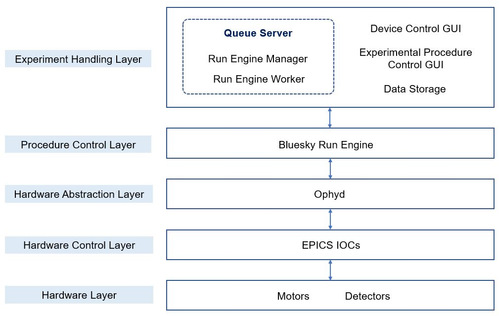
The Bluesky Queue Server serves as the core of the data acquisition system. Users upload Plans to the Queue Server, where they are executed autonomously and sequentially. The Queue Server runs as a multi-process service, with the Run Engine Manager as the central component responsible for maintaining and executing the Plan queue. Plans are executed in a separate process within the Run Engine Worker environment. The Queue Server provides Plan queue management services, maintaining a queue of multiple Plans in Redis. The GUI is developed using the Bluesky Queue Server API and Bluesky Widgets.
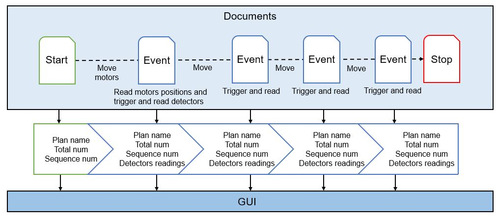
4)Experimental Data Management System
The Experimental Data Management System is responsible for the full lifecycle management of experimental data generated by the light source across various stages, including data acquisition, storage, analysis, and data publication. The light source will generate petabytes of experimental data annually. These massive data are centrally stored and managed by the Experimental Data Management System, which provides users with data access services in compliance with the FAIR principles.
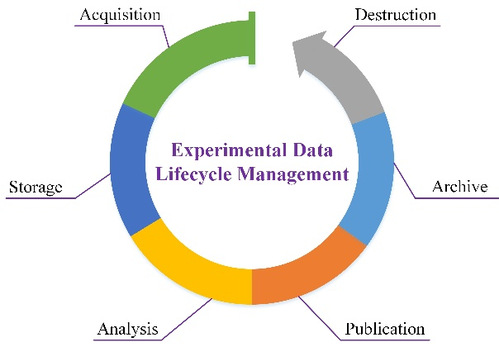
The full lifecycle management of experimental data
The light source experimental data is stored using the Nexus/HDF5 file format, which includes both raw data and comprehensive metadata. The GPFS distributed file system is employed for data file storage. Metadata is collected using the Kafka message queue and managed by the SciCat metadata catalog. The system provides web-based data access services to users.
5)Experimental Data Analysis System
The experimental data analysis system is designed to process the massive volumes experimental data, which integrates advanced data analysis and management tools. The software provide the scalable distributed heterogeneous computing power, meet the processing demands of multimodal data. The algorithm integrates the spectroscopy, diffraction/scattering, and imaging algorithm libraries, supporting flexible invocation by users. The user interface provides two access modes: a PyQt5-based Workbench and a JupyterLab-based web client, offering flexible choices to users.
Back

